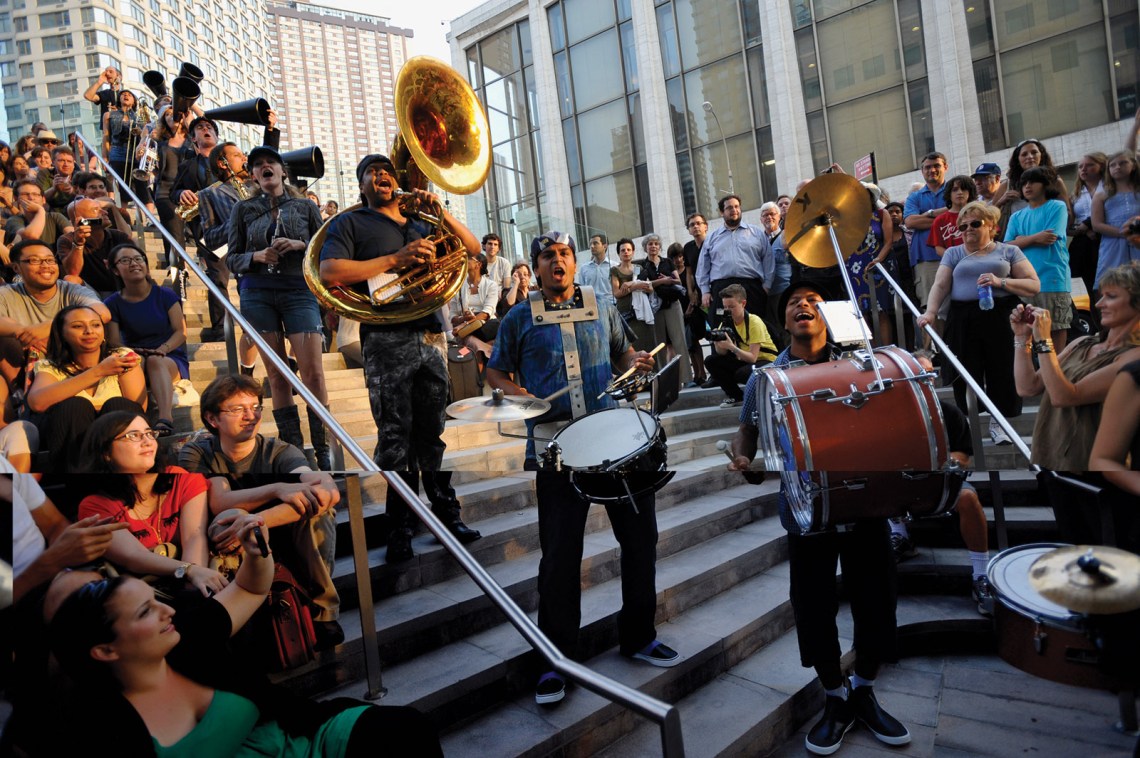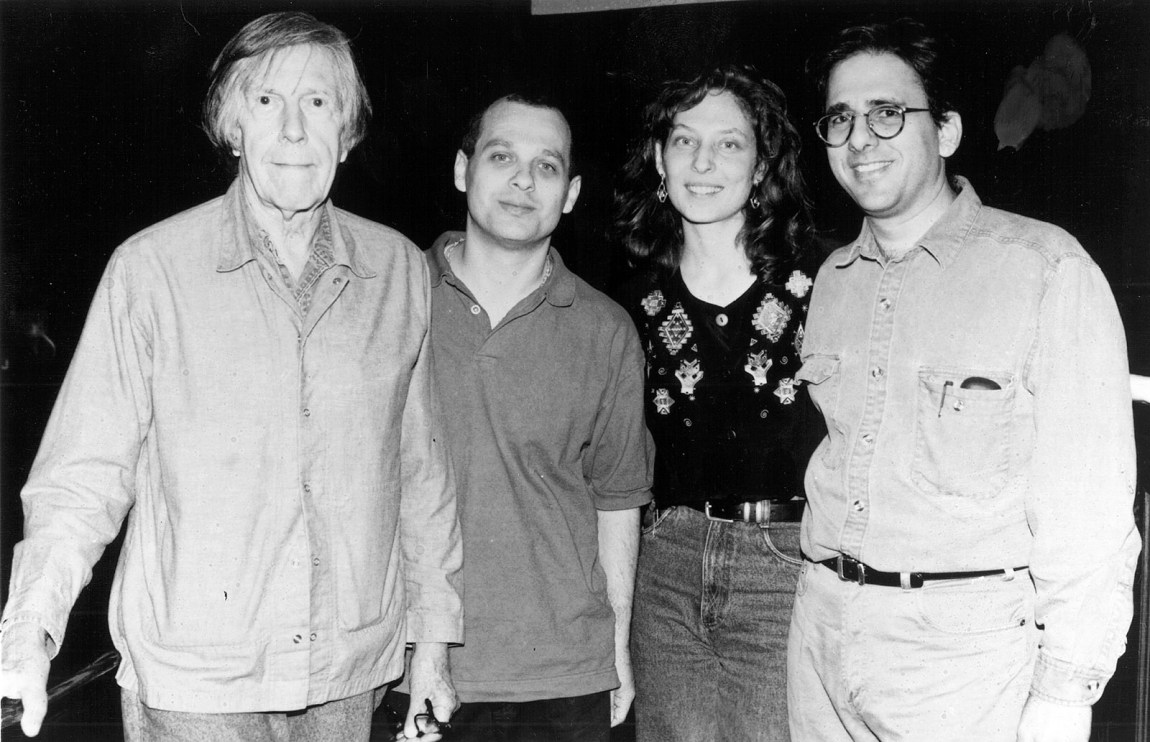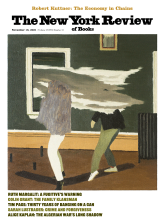On Mother’s Day 1987, at the Exit Art gallery in SoHo, a new group called Bang on a Can presented a twelve-hour marathon concert of contemporary music played by a variety of soloists and ad hoc ensembles. Except for Igor Stravinsky, all of the twenty-eight composers whose works were performed were still living, more than half of them were under thirty-five, and many were in attendance. The mood was expansive and informal, and the concert was as notable for its breadth as for its length.
No program notes were provided. “We’re young composers interested in all the possibilities, all the directions that are open to us,” David Lang, who founded Bang on a Can with Julia Wolfe and her husband, Michael Gordon, explained at the time. “We wanted to combine the music of different composers who don’t usually share programs—to put things side by side that you don’t usually find side by side. You hear differently that way.” And why the name Bang on a Can? “So people would ask about it,” Lang said. They did.
In a world increasingly addicted to “random play” in the streaming of its music, such stylistic diversity may seem a minor matter. It wasn’t inconsequential at the time, though, when composers moved in deeply divided circles, chasing the same small audiences and foundation dollars with a sense of rivalry and sometimes outright enmity. At this festival, the flashing, cinéma vérité–like complications of Milton Babbitt’s Vision and Prayer shared the program with Steve Reich’s Four Organs, a dogged examination of a single chord drawn out for nearly twenty minutes, and George Crumb’s Black Angels, an eerie evocation of diabolism for electric string quartet. Some of the pieces might not have been out of place at a jazz or rock concert.
The audience was occasionally encouraged to participate, an activity then more commonly reserved for churches, children’s concerts, folk music, and an occasional sing-along Messiah. Early in the afternoon, Pauline Oliveros led the audience in a “Tuning Meditation.” The score read, in full: “Using any vowel sound, sing a tone that you hear in your imagination. After contributing your tone, listen for someone else’s tone and tune to its pitch as exactly as possible. Sing warmly.” And so we did—high squeak and basso profundo, tentative at first, then confident, combining in a restful hum that settled on the room. The sirens of lower Broadway seemed far away.
Industry: Bang on a Can and New Music in the Marketplace, by William Robin, an assistant professor of musicology at the University of Maryland, is a colorful, insightful, and admirably evenhanded study of Bang on a Can in its early years and, by extension, of the creative upheavals in the music world at the end of the twentieth century. Robin wasn’t yet born in 1987, and his separation from the internecine battles of the time is welcome; still, such is his understanding of them that I found myself thinking back decades to conversations in bars around Lincoln Center and in SoHo, where some of us who were young then would argue music late into the night. Robin would have fit right in.
“Industry” can suggest commercial endeavor, hard work, or sheer physical or intellectual busyness, and the book touches on all three. (It is also the title of a piece by Gordon.) Lang, Wolfe, and Gordon had become friends during their graduate studies at Yale, when they were in their twenties. As Robin tells it:
In the years after the first Bang on a Can marathon, the organization’s founders would tell and retell the story of why the New York new-music scene of the time so badly needed a new festival. When Gordon and Lang first arrived in New York, they would trek to McMillin at Columbia, Merkin Concert Hall on 67th Street, and Carnegie Recital Hall to hear reputable ensembles like Speculum Musicae and the Group for Contemporary Music perform works by Elliott Carter, Charles Wuorinen, and Columbia graduate students. And Gordon, Lang, and Wolfe would all hang out in their downtown environs to see improvised performances by John Zorn and Shelley Hirsch at the venue Roulette;1 pulsating drones from Ellen Fullman and Arnold Dreyblatt at Phill Niblock’s Experimental Intermedia loft; and the multimedia spectacles of Robert Ashley at The Kitchen.
The trio liked much of the music they heard, but not the vibe surrounding it. The two musical universes—the one that housed ensembles performing precisely notated, atonal music on the Upper West Side, and the one that comprised composer-performers rendering their own quasi-improvisatory experimentations below 14th Street—felt divided, with their own attendant aesthetics, ideologies, and practices.
Lang, who did much of the talking for Bang on a Can, put it more concisely:
Advertisement
If you went to hear Speculum Musicae, there was invariably one composer doing great stuff in an ugly language, and the others were bad composers working in the same ugly language. Same thing Downtown: there’d be a free, sonic piece by a really good composer and a bad sonic piece right behind it. Pieces were being grouped by ideology, not quality.
There were reasons for his defensiveness: audiences for symphony and concert music had been dwindling for some time. For most of its history in the United States, “classical music” had meant orchestral music, and by 1987 it had been quite a while since any significant new composition had excited the public. In the decades after World War II, pieces by then-active composers such as Aaron Copland, Samuel Barber, Dmitri Shostakovich, Aram Khachaturian, Olivier Messiaen, and Carl Orff—above all his pagan cantata Carmina Burana—could still sell out a house, as could Stravinsky’s earlier works. But classical audiences were mostly looking backward: new works would be accorded the prestige of a premiere, but they were not likely to be revived.
For many, it felt as though the connection between audiences and composers had been ruptured. When Babbitt proposed a Ph.D. program for composers at Princeton in 1960, he, Edward Cone, and Arthur Mendel put the problem in near-apocalyptic terms. “It must be realized that university teaching provides the only means whereby the composer can exist within his profession,” they wrote in a memo. “To deny his right to teach is to deny serious music its right to exist.”
The trouble went beyond the concert hall. Recordings of what Babbitt called “serious” music operated at a financial loss. Labels like the American Recording Society and Composer Recordings Inc. (CRI) relied mostly on grants, so they weren’t particularly worried, but their discs were hard to find in stores. The one bright spot among the commercial labels was Columbia Masterworks, later CBS Masterworks and now Sony Classical. Goddard Lieberson, Columbia’s president from 1956 through much of the 1970s, was himself a composer and felt a duty to put a good amount of the money earned by My Fair Lady and other Broadway show recordings back into less immediately popular new music.2
A few of those Columbia recordings never went out of print, nor does it seem they will (whatever “in print” may mean in the future). Pieces by composers such as Steve Reich, Terry Riley, and later Philip Glass attracted a surprise following. Their music was radically different from much other contemporary work of the time: harmonic motion was infrequent, the scores often involved drones or fierce reiteration with a steady pulse, and the resulting sound was sometimes compared to that of a stuck record. It was referred to as “trance music” or “solid-state music”; eventually the term “minimalist” would be attached, much to the irritation of some of its pioneers, who were by then writing full-length operas and works for large orchestras.
I presented a great deal of contemporary music on New York radio in the late 1970s and early 1980s, and I noticed that minimalist works always provoked some angry phone messages—I’d never before been the target of so much furious, anonymous rage—while other callers were transfixed, even ecstatic. The densely chromatic modern music that I programmed, the sort sometimes described inexactly as “dissonant,” was rarely commented upon, though it was unclear whether that meant it was admired privately or merely put up with.
The minimalist composers played much of their music themselves and took their ensembles around the United States and Europe. For many young musicians, it seemed a fulfillment of youthful dreams about starting a rock band. Soon there was a company called the New Music Distribution Service, which would carry any recording produced by an independent label that could be loosely referred to as new music. It ended up with more than two thousand titles, permitting composers to disseminate their music, no matter what anyone thought of it or how many copies were sold.
But it was Meet the Composer, a nonprofit group founded by the late John Duffy in 2002 and run with Frances Richard, that began to break down the divisions within contemporary music. Robin sums up their contribution:
The profession would strengthen, Duffy believed, if composers stood in solidarity, and the organization thus advocated for transcending the bitter feuds between minimalists, serialists, neo-Romantics, and other camps that were pervasive in the 1970s and 1980s. Circa 1984, Meet the Composer’s advisory board of forty-two composers included a broad representation of figures from different areas of the compositional world, including academics Milton Babbitt and Roger Reynolds, experimentalists Ornette Coleman and Muhal Richard Abrams, minimalists Philip Glass and La Monte Young, and orchestral composers Joan Tower and Libby Larsen.
A pragmatic utopian, Duffy envisioned a time when “composers will be in the streets…[alongside] doctors, lawyers, corporate managers, and other professionals.” He wanted to challenge the popular impression that composers were necessarily dead Europeans. Meet the Composer set up a nationwide system to bring composers into public view through performing, conducting, speaking with audiences, presenting workshops, giving interviews, and coaching rehearsals throughout the country. Duffy’s group found financial support wherever it could, and fresh possibilities soon opened up. Several leading orchestras engaged “composers-in-residence” at generous salaries, and it especially delighted Duffy when Corning Glass Works commissioned a piece for the opening of a new wing in its Museum of Glass.
Advertisement
In the 1980s and 1990s, with the eager support of Meet the Composer, Bang on a Can became what the guitarist Robert Fripp used to call “a small, independent, mobile, and intelligent unit.” By the time Bang on a Can was in the process of planning its tenth anniversary, Robin writes, the group had become a business:
A July 1996 memo lists more than a dozen corporations and foundations from whom they intended to seek support, each with a detailed “plan of attack” outlining proposals and meetings. For the anniversary season, Bang on a Can’s budget of $429,000 included $179,000 of foundation and corporate support, with a $50,000 grant from the Rockefeller Foundation as well as their first major corporate sponsorships: $15,000 from Philip Morris toward the festival, and $15,000 from AT&T to support a national [Bang on a Can] All-Stars tour. Twenty-thousand people had attended forty-seven concerts featuring music by fifty-six composers, and Bang on a Can had netted an impressive $203,000 from earned income.
Bang on a Can started a collective program for commissioning new works and suggested contributions between $50 and $5,000. It formed its own marching band, the Asphalt Orchestra, and started a summer festival in Massachusetts that was nicknamed “Banglewood,” a play on the more conservative Tanglewood Festival forty-five minutes to the south. And it made copious recordings, with stops at CRI, Sony, and Nonesuch before founding its own label, Cantaloupe Music. In Robin’s view,
it was precisely the flexibility and nimbleness of Bang on a Can—the fact that it was a top-down organization whose scope was determined by only three composers—that helped them endure, and even expand, in moments of economic downturn. They did not need to serve multiple constituencies, negotiate the needs of different presenters, or satisfy different factions.
Robin also argues that
Bang on a Can’s entrepreneurialism could serve as a defense against critique, even as the organization became increasingly established. “People now come to BoaC to stand at the back and complain,” Lang told [the Village Voice critic Kyle] Gann in 1993. “They tell us, ‘You’re not representing our music.’ We say, ‘Well, when we started out, no one was representing our music. Go out and start your own festival.’ The more festivals we have, the better.”
These were years of optimism, when everything seemed possible. Yet the end of Robin’s book is wistful:
In many ways, then, Bang on a Can was ahead of their time, building a lasting institution through individual perseverance and go-getting. But Bang on a Can was also a product of their time. They amassed support from the government and foundations, from record labels and presenters, because their ambitions were attuned to a marketplace ethos pervasive in the late twentieth century. In this present-day era of arts austerity, however, the resources that they marshalled are not necessarily available to those who seek to imitate their entrepreneurial spirit. In separate interviews in the winter of 2016, Wolfe and Gordon both made an analogy between the current new-music world and the restaurant industry—if there is more than one restaurant on a city block, they might compete with one another, but they also draw more people to that area generally, and thus everyone wins. When the composers first started out, new music was still a fringe phenomenon. Now, it is a cottage industry with a bigger audience and a seemingly limitless expanse of opportunities, in which everyone can find their own niche. But it’s also a crowded market, and every new ensemble and record label has to build its own brand and relentlessly fundraise and market itself. Opportunities have proliferated; stability remains elusive.
Of course, it is now hard for any group of “hungry artists” to find a place in New York. The rock musician Patti Smith, whose recordings and imagery had once inspired so many to run away to the city, no longer proselytizes for it. “New York has closed itself off to the young and the struggling,” she said in an interview at Cooper Union in 2010. “But there are other cities…. New York City has been taken away from you. So my advice is: Find a new city.” A number of smaller, struggling cities—Detroit, Baltimore, Cleveland, Pittsburgh—soon found themselves with budding bohemias.
Industry was completed in the first year of the Covid pandemic, at a time when concertgoing worldwide came to an abrupt halt for more than a year. Yet Bang on a Can managed to carry on, offering a virtual festival, streaming music from homes, studios, and all-but-empty auditoriums in May 2020. And last summer the group presented twenty hours of performances as part of the so-called LOUD Weekend from the Mass MoCA complex in North Adams, Massachusetts. “Venturing back to live performances and finding a classical music institution in rude health can be like putting on a pair of old jeans and discovering, with relief, an easy fit,” wrote Seth Colter Walls in his review for The New York Times.
In such haunted times, nobody can tell how long that “fit” may last, but it is heartening to know that interest and energy remain.
-
1
Roulette continues to present concerts and other events in New York. Its archive is a trove of material dating back to 1978, with more than 2,500 concerts now available free to anybody who wants to listen. See roulette.org/archive. ↩
-
2
Generous box sets devoted to the pioneering Juilliard String Quartet, New Music String Quartet, and Fromm Foundation–sponsored recordings have been recently released by Sony—more than thirty discs altogether; they contain much fine music and I strongly recommend them. ↩





